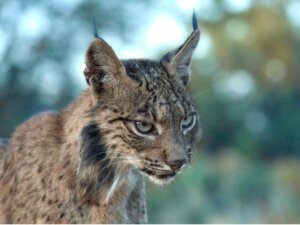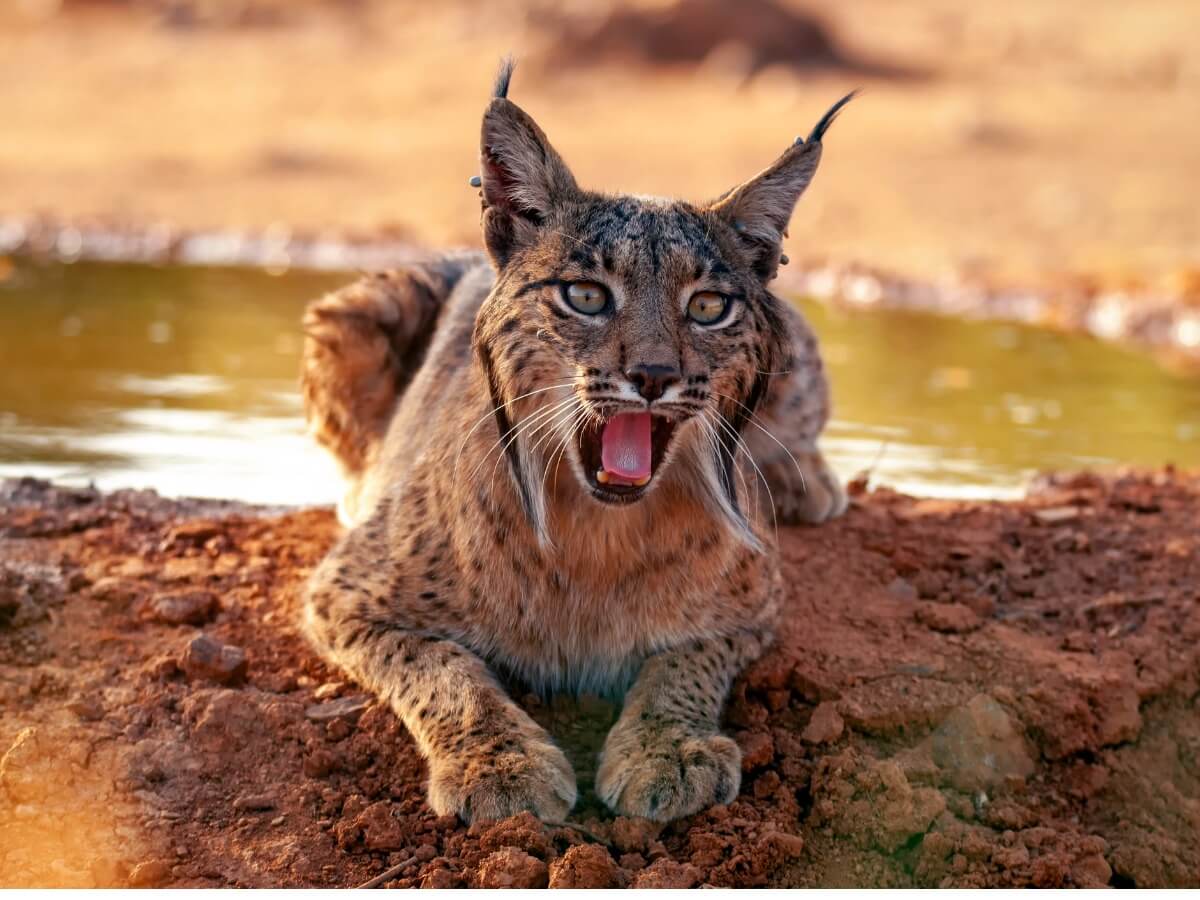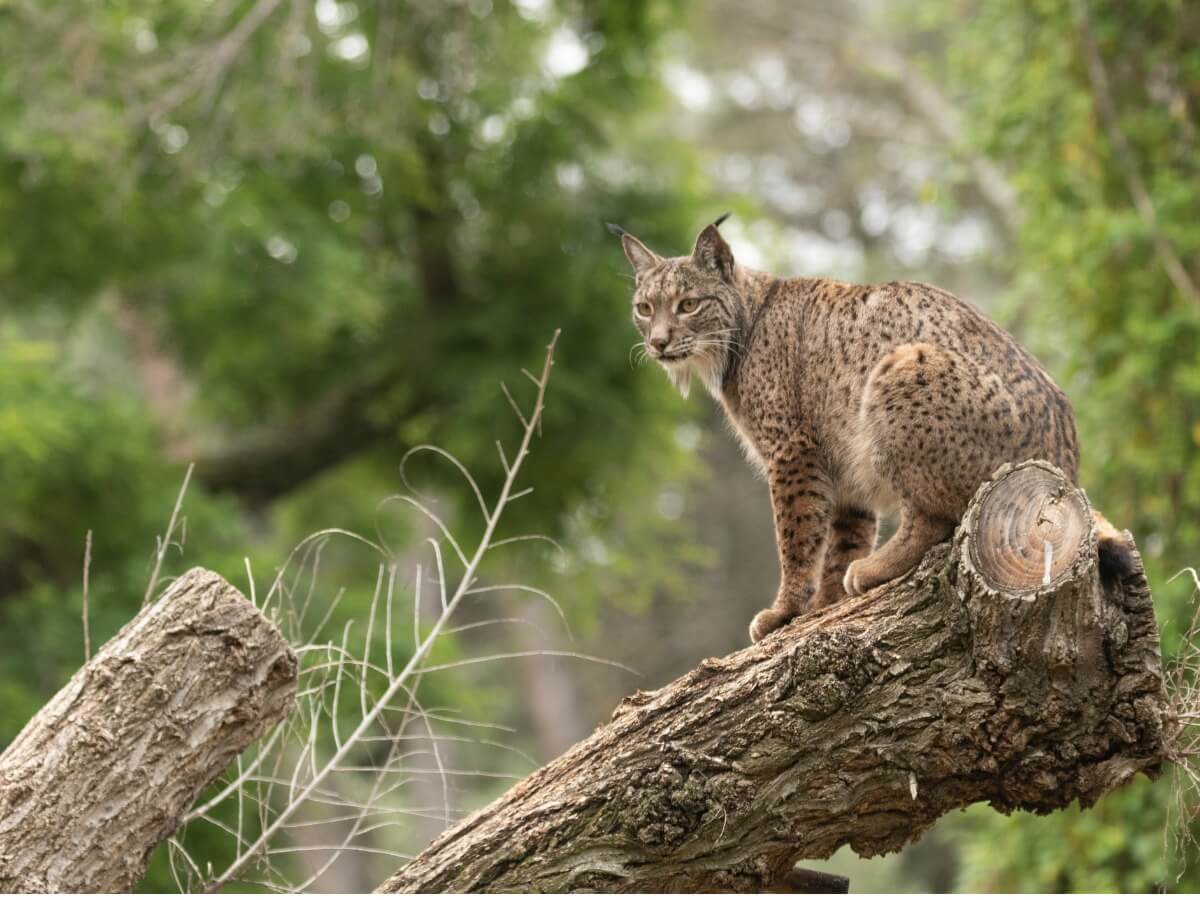Behavior of the Iberian Lynx

The animal in question, the most threatened feline in the world, needs all the help it can get to recover. Studying the behavior of the Iberian lynx is just as important as all other areas of its life when it comes to revitalizing the population of this species.
Often, the species closest to us are the least known, and this can lead to us not doing the little things that we could to help them. In this article, you’ll learn all about the behavior and habits of this incredible animal.
Characteristics of the Iberian lynx
The Iberian lynx (Lynx pardinus) is a species of mammal belonging to the Felidae family, endemic to the Iberian Peninsula. They’re small animals in relation to other species of lynx: their average height never exceeds 55 centimeters (21 inches) and their weight is around 10 kilograms (22 pounds).
Of the four species of lynx that exist, the Iberian has the most restricted distribution. It mainly inhabits scrub areas and rocky or mountainous formations with altitudes below 1300 meters (4260 feet). It usually takes refuge in caves.
It’s a strictly carnivorous animal, whose diet is almost entirely based on wild rabbits. For this reason, during the two epidemics that the rabbits of the area suffered in the 1950s, the Iberian lynx population was in danger along with them, as these carnivores had nothing to eat.
This felid has a marked sexual dimorphism in terms of size: males are much larger than females.

The character of the Iberian lynx
It’s a feline with twilight habits, whose activity peaks coincide with those of its prey: at dusk and the early morning. Between these two periods, it’s most active in the early hours of the night. Differences in activity are also observed according to sex: males are much more active than females.
Iberian lynxes are solitary. They only seek each other out for mating and the groups are only made up of mothers and young. On rare occasions, more than one adult may be found feeding on large prey.
The behavior of the Iberian lynx
Most of the ethological studies carried out on the Iberian lynx have been in captivity. Valuable data for their conservation have been obtained from these investigations that can be compared with in situ studies, which progress more slowly due to the difficulty of observing specimens in their natural environment.
Social behavior
Like most felids, the behavior of the Iberian lynx is usually solitary and territorial. Typically, its area can span up to 30 square kilometers (18 miles), depending on the availability of dams and water, as well as shelters and the presence of competitors.
Male and female territories can overlap. However, the males’ territory is usually broader. Both sexes, however, mark the limits of their foraging area through urine and claw marks on trees and soil.
Urine also gives information on the health, sex, and reproductive status of lynxes.
Eating behavior
90% of the diet of the Iberian lynx is based on wild rabbits (Oryctolagus cuniculus), although it can also feed on other prey: hare (Lepus granatensis), different species of birds, rodents and, rarely, fawns.
The behavior of the Iberian lynx during the hunt follows a typical ambush strategy, similar to the rest of the felines. When the prey is small, the lynx usually transport it to a safe place to eat it. When, on the other hand, the victim is larger than the felid, it kills it with a bite to the throat, pressing on the windpipe to cut off its breath.
On rare occasions, cooperative behavior can be observed between breeding pairs for hunting. When it comes to feeding, males have preference over females, unless the female has suckling young. Within the young, hierarchy is also observed when it comes to eating, since the largest are the first to feed.
Reproductive behavior
The most common mating system in Lynx pardinus is polygyny, a strategy in which the male copulates with as many females as he can. Normally, this is subject to the availability of females that overlap their territory with that of the male.
The Iberian lynx reaches reproductive maturity at 2 years. However, it isn’t until a territory of their own has been established that females begin to be sexually available. Estrus is seasonal and usually occurs in winter.
During the mating season, females begin to vocalize with specific calls to indicate heat. The available males enter the territory of the females, a space that they will share for 2 or 3 weeks until they mate.
After mating, the females look for a refuge that offers them protection against predators and inclement weather. Gestation lasts between 63 and 66 days, and deliveries usually occur at the end of March. They can give birth to 2 to 4 cubs that only the mother will take care of, as the male leaves the territory after copulation.
During lactation – which lasts between 5 and 6 months – the female can change shelters. The cubs remain with their mother until the dispersal period begins after their first year of life, which is when the pups gradually separate from the parent as they become independent.
Conservation status of the Iberian lynx
The Iberian lynx is in danger of extinction. Their greatest threats are habitat loss from indiscriminate logging and urbanization, as well as poaching. Accidental road deaths were also documented where roads had been built in their places of passage.
Fortunately, its population is increasing thanks to the conservation efforts of various organizations. Captive breeding programs and the protection of their territories are bearing small and hopeful fruits for these felines.

Yet these victories are achieved through thick and thin, with budget cuts, poachers going unpunished, and construction companies invading their territories. Supporting these organizations, even with dissemination through the networks, is also a fundamental job so that these wonderful felines continue to populate the Peninsula.
The animal in question, the most threatened feline in the world, needs all the help it can get to recover. Studying the behavior of the Iberian lynx is just as important as all other areas of its life when it comes to revitalizing the population of this species.
Often, the species closest to us are the least known, and this can lead to us not doing the little things that we could to help them. In this article, you’ll learn all about the behavior and habits of this incredible animal.
Characteristics of the Iberian lynx
The Iberian lynx (Lynx pardinus) is a species of mammal belonging to the Felidae family, endemic to the Iberian Peninsula. They’re small animals in relation to other species of lynx: their average height never exceeds 55 centimeters (21 inches) and their weight is around 10 kilograms (22 pounds).
Of the four species of lynx that exist, the Iberian has the most restricted distribution. It mainly inhabits scrub areas and rocky or mountainous formations with altitudes below 1300 meters (4260 feet). It usually takes refuge in caves.
It’s a strictly carnivorous animal, whose diet is almost entirely based on wild rabbits. For this reason, during the two epidemics that the rabbits of the area suffered in the 1950s, the Iberian lynx population was in danger along with them, as these carnivores had nothing to eat.
This felid has a marked sexual dimorphism in terms of size: males are much larger than females.

The character of the Iberian lynx
It’s a feline with twilight habits, whose activity peaks coincide with those of its prey: at dusk and the early morning. Between these two periods, it’s most active in the early hours of the night. Differences in activity are also observed according to sex: males are much more active than females.
Iberian lynxes are solitary. They only seek each other out for mating and the groups are only made up of mothers and young. On rare occasions, more than one adult may be found feeding on large prey.
The behavior of the Iberian lynx
Most of the ethological studies carried out on the Iberian lynx have been in captivity. Valuable data for their conservation have been obtained from these investigations that can be compared with in situ studies, which progress more slowly due to the difficulty of observing specimens in their natural environment.
Social behavior
Like most felids, the behavior of the Iberian lynx is usually solitary and territorial. Typically, its area can span up to 30 square kilometers (18 miles), depending on the availability of dams and water, as well as shelters and the presence of competitors.
Male and female territories can overlap. However, the males’ territory is usually broader. Both sexes, however, mark the limits of their foraging area through urine and claw marks on trees and soil.
Urine also gives information on the health, sex, and reproductive status of lynxes.
Eating behavior
90% of the diet of the Iberian lynx is based on wild rabbits (Oryctolagus cuniculus), although it can also feed on other prey: hare (Lepus granatensis), different species of birds, rodents and, rarely, fawns.
The behavior of the Iberian lynx during the hunt follows a typical ambush strategy, similar to the rest of the felines. When the prey is small, the lynx usually transport it to a safe place to eat it. When, on the other hand, the victim is larger than the felid, it kills it with a bite to the throat, pressing on the windpipe to cut off its breath.
On rare occasions, cooperative behavior can be observed between breeding pairs for hunting. When it comes to feeding, males have preference over females, unless the female has suckling young. Within the young, hierarchy is also observed when it comes to eating, since the largest are the first to feed.
Reproductive behavior
The most common mating system in Lynx pardinus is polygyny, a strategy in which the male copulates with as many females as he can. Normally, this is subject to the availability of females that overlap their territory with that of the male.
The Iberian lynx reaches reproductive maturity at 2 years. However, it isn’t until a territory of their own has been established that females begin to be sexually available. Estrus is seasonal and usually occurs in winter.
During the mating season, females begin to vocalize with specific calls to indicate heat. The available males enter the territory of the females, a space that they will share for 2 or 3 weeks until they mate.
After mating, the females look for a refuge that offers them protection against predators and inclement weather. Gestation lasts between 63 and 66 days, and deliveries usually occur at the end of March. They can give birth to 2 to 4 cubs that only the mother will take care of, as the male leaves the territory after copulation.
During lactation – which lasts between 5 and 6 months – the female can change shelters. The cubs remain with their mother until the dispersal period begins after their first year of life, which is when the pups gradually separate from the parent as they become independent.
Conservation status of the Iberian lynx
The Iberian lynx is in danger of extinction. Their greatest threats are habitat loss from indiscriminate logging and urbanization, as well as poaching. Accidental road deaths were also documented where roads had been built in their places of passage.
Fortunately, its population is increasing thanks to the conservation efforts of various organizations. Captive breeding programs and the protection of their territories are bearing small and hopeful fruits for these felines.

Yet these victories are achieved through thick and thin, with budget cuts, poachers going unpunished, and construction companies invading their territories. Supporting these organizations, even with dissemination through the networks, is also a fundamental job so that these wonderful felines continue to populate the Peninsula.
All cited sources were thoroughly reviewed by our team to ensure their quality, reliability, currency, and validity. The bibliography of this article was considered reliable and of academic or scientific accuracy.
- Aldama, J. J., Delibes, M. (1991a). Observation of feeding groups in the Spanish Lynx (Felis pardina) in the Doñana National Park, SW Spain. Mammalia, 55: 143-147.
- Lince ibérico – Lynx pardinus – Comportamiento. (2021). Vertebrados Ibéricos. http://www.vertebradosibericos.org/mamiferos/comportamiento/lynparco.html
- Rodríguez, A. & Calzada, J. 2015. Lynx pardinus (errata version published in 2020). The IUCN Red List of Threatened Species 2015: e.T12520A174111773. https://dx.doi.org/10.2305/IUCN.UK.2015-2.RLTS.T12520A174111773.en. Downloaded on 06 July 2021.
- Penabad, L. et al. (2012). Ritmos de actividad del lince ibérico (Lynx pardinus) en cautividad. Galemys, 24: 57-63.
- Yerga Rufo, F. J. (2015). Ontogenia del comportamiento del lince ibérico (Lynx pardinus) en cautividad (Tesis). Universidad de Huelva, Huelva.
- Cabezas-Díaz, S., Lozano, J., & Virgós, E. (2009). The declines of the wild rabbit (Oryctolagus cuniculus) and the Iberian lynx (Lynx pardinus) in Spain: redirecting conservation efforts. Handbook of nature conservation: global, environmental and economic issues, 283-310.
- Lynx pardinus (Spanish lynx). (2021). Animal Diversity Web. https://animaldiversity.org/accounts/Lynx_pardinus/
This text is provided for informational purposes only and does not replace consultation with a professional. If in doubt, consult your specialist.








